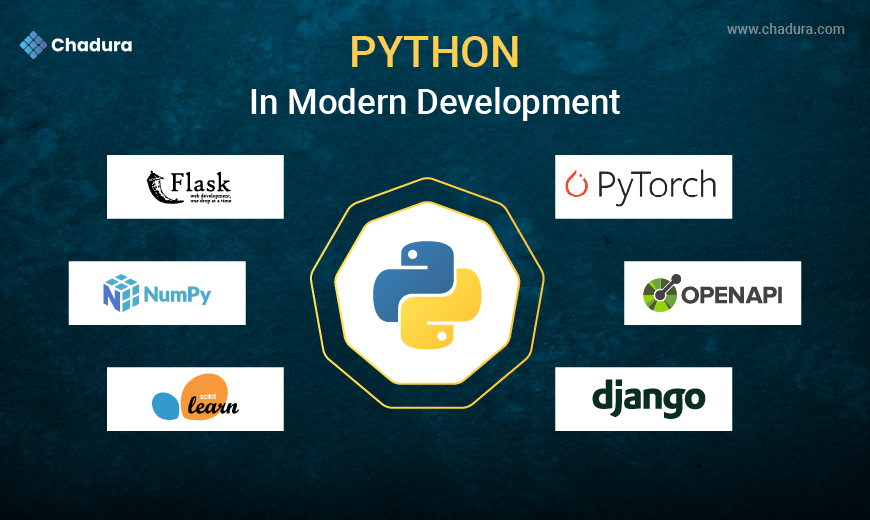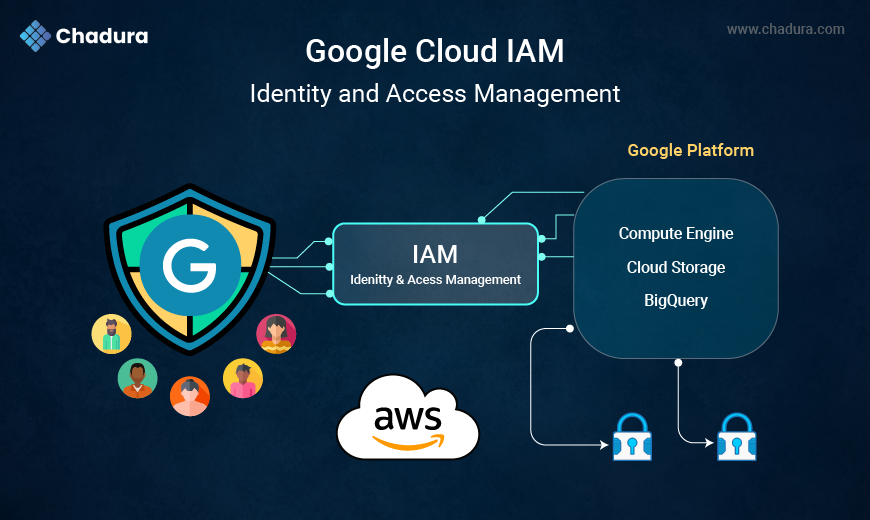The Power of Python in Modern Development
In today’s digital landscape, technology evolves faster than ever. From AI-driven systems to cloud-native applications, innovation thrives on languages that balance simplicity with power. Python stands tall in this regard — a language celebrated for its readability, scalability, and an ecosystem enriched with thousands of libraries that turn complex problems into elegant solutions.
At Chadura Tech, Python forms the backbone of many innovations. Whether it’s data analytics platforms, AI-based automation systems, or full-stack web applications, our teams rely on the versatility of Python and its ever-growing ecosystem of libraries. These libraries empower our engineers to move from idea to implementation quickly, ensuring reliability and performance at scale.
But not every library deserves a place in every developer’s toolkit. Some libraries define how Python has reshaped modern software development. In this article, we explore the top 10 Python libraries every developer should know, with real-world insights from Chadura Tech’s engineering practices.

1. NumPy – The Foundation of Numerical Computing
What is NumPy?
NumPy (Numerical Python) is the cornerstone of Python’s scientific computing stack. It introduces multidimensional arrays (ndarrays) and supports advanced mathematical operations — vectorization, broadcasting, and matrix manipulation — with exceptional performance thanks to its C-based core.
Key Features
- High-performance n-dimensional arrays.
- Broadcasting for efficient operations across data sets.
- Linear algebra, Fourier transforms, and random number capabilities.
- Seamless integration with other libraries like Pandas and SciPy.
Why Developers Love It
NumPy removes the need for explicit loops when handling large numerical datasets, making code cleaner and faster. It’s the foundation upon which most Python data libraries are built.
Chadura Tech Perspective
At Chadura Tech, NumPy powers the core data-processing layer of several projects. For instance, during the development of AI analytics for internal dashboards, NumPy handles bulk transformations before passing structured data to machine learning models. Its speed and efficiency help our teams process gigabytes of numerical logs and metrics with minimal latency.
2. Pandas – Data Analysis Made Simple
What is Pandas?
If NumPy is the backbone, Pandas is the brain of Python data analytics. It brings flexible, powerful tools to manage structured data through Series and DataFrames. Developers can load, clean, analyze, and visualize data with ease — turning raw data into actionable insights.
Key Features
- Intuitive data structures: Series (1D) and DataFrame (2D).
- Powerful I/O: CSV, JSON, SQL, Excel, Parquet, and more.
- Data cleaning, reshaping, and merging.
- Built-in time series functionality.
Why Developers Love It
Pandas allows analysts and engineers to handle millions of rows effortlessly. It simplifies everyday data operations — filtering, aggregation, joining — that would otherwise take extensive effort in raw Python.
Chadura Tech Perspective
Chadura Tech’s data intelligence teams rely heavily on Pandas for data ingestion pipelines and ETL (Extract, Transform, Load) workflows. In one of our AI-driven financial insight projects, Pandas enabled the team to cleanse and unify heterogeneous datasets before passing them to machine learning models — ensuring quality, consistency, and performance across analytics layers.
3. Matplotlib – Visualizing the Story Behind Data
What is Matplotlib?
Matplotlib is Python’s oldest and most versatile plotting library. It transforms data into insightful visuals — from simple bar graphs to complex 3D surfaces — making analysis intuitive and storytelling more powerful.
Key Features
- Extensive 2D/3D plotting capabilities.
- Customizable styles and themes.
- Integration with Pandas and NumPy.
- Support for multiple output formats (PNG, PDF, SVG).
Why Developers Love It
Data visualization is crucial for understanding trends and outliers. Matplotlib’s flexibility makes it ideal for prototyping and publication-ready charts alike.
Chadura Tech Perspective
Visualization is at the heart of Chadura Tech’s business intelligence approach. Our engineering dashboards use Matplotlib for analytical reporting, KPI monitoring, and performance tracking. Combined with Pandas, it enables teams to visualize live operational data — turning raw metrics into comprehensible insights for management and clients.
4. Scikit-learn – Simplifying Machine Learning
What is Scikit-learn?
Scikit-learn is a high-level library for machine learning and statistical modeling. Built on NumPy, SciPy, and Matplotlib, it provides a consistent interface for tasks like classification, regression, clustering, and model evaluation.
Key Features
- Rich collection of algorithms (SVM, Random Forest, K-Means, etc.).
- Preprocessing utilities (scaling, encoding, normalization).
- Pipeline integration for automation.
- Model selection, cross-validation, and metrics.
Why Developers Love It
It abstracts the complexity of implementing algorithms from scratch, making it easy to build, train, and deploy predictive models quickly.
Chadura Tech Perspective
Scikit-learn forms the AI core of Chadura Tech’s internal machine learning experiments and prototypes. Our Genix.AI engine leverages Scikit-learn pipelines for early-stage model testing, classification tasks, and proof-of-concept development before migrating to deep learning frameworks. Its simplicity and speed make it ideal for rapid AI innovation.
5. TensorFlow – Powering AI and Deep Learning
What is TensorFlow?
Developed by Google, TensorFlow is a deep learning framework designed for building and deploying large-scale neural networks. It supports everything from training complex models on GPUs to running lightweight inference on edge devices.
Key Features
- Computational graphs and tensor operations.
- GPU/TPU acceleration.
- High-level APIs like Keras for rapid prototyping.
- TensorBoard for training visualization.
- Cross-platform deployment (mobile, web, edge).
Why Developers Love It
TensorFlow’s scalability allows developers to train models on massive datasets and deploy them seamlessly in production environments.
Chadura Tech Perspective
At Chadura Tech, TensorFlow powers AI-driven solutions across domains — from genomic data interpretation in healthcare projects to automated content tagging in digital platforms. Its performance and ecosystem help our engineers accelerate deep learning pipelines while maintaining production reliability and compliance.
6. PyTorch – Dynamic Deep Learning Framework
What is PyTorch?
Developed by Facebook’s AI Research Lab, PyTorch has emerged as the preferred deep learning library for research and innovation. Its dynamic computational graph allows developers to modify models during runtime — making experimentation faster and more intuitive.
Key Features
- Dynamic graph execution (eager mode).
- Tensor computation with GPU acceleration.
- Autograd system for automatic differentiation.
- Strong community and library extensions.
Why Developers Love It
PyTorch offers a Pythonic, flexible development experience, making it ideal for research and iterative AI development.
Chadura Tech Perspective
Chadura Tech uses PyTorch in R&D environments for custom neural architectures, generative models, and AI experimentation. Its flexibility enables our data science teams to design and test new algorithms rapidly before integrating them into production systems. In our Vybe-Matrix project, PyTorch contributed to real-time communication sentiment modeling.
7. Django – The Framework for Web Perfection
What is Django?
Django is a high-level Python web framework that encourages rapid development and clean, pragmatic design. It comes with an ORM, admin interface, authentication system, and robust security — all out of the box.
Key Features
- MVT (Model-View-Template) architecture.
- Integrated ORM and admin interface.
- Built-in security (CSRF, XSS, SQL injection protection).
- Scalability and caching integration.
Why Developers Love It
Django reduces development time by handling repetitive tasks automatically, allowing developers to focus on building applications, not boilerplate.
Chadura Tech Perspective
Django is central to several Chadura Tech platforms, including CIT-Alumni and Relay, where we built scalable backend systems integrated with Caddy and Docker. Its robustness, security, and maintainability make it ideal for enterprise-grade applications that demand reliability and long-term support.
8. Flask – Lightweight Power for APIs and Microservices
What is Flask?
Flask is a micro web framework that gives developers freedom and flexibility. Unlike Django, Flask is minimalistic — you add only the components you need.
Key Features
- Lightweight, modular architecture.
- Built-in development server and debugger.
- RESTful request handling.
- Easy integration with extensions (SQLAlchemy, Jinja2).
Why Developers Love It
Flask’s simplicity makes it perfect for microservices, APIs, and prototyping. Developers can scale functionality as the application grows.
Chadura Tech Perspective
Flask powers many internal services and lightweight APIs within Chadura Tech’s ecosystem. For example, several AI microservices — such as text sentiment analysis and notification delivery — run on Flask due to its fast startup time and easy containerization.
9. FastAPI – The Modern Framework for APIs
What is FastAPI?
FastAPI is a next-generation web framework for building APIs with Python 3.7+ based on type hints. It’s fast (thanks to ASGI and Starlette) and developer-friendly with automatic documentation via Swagger and ReDoc.
Key Features
- Async support for high-performance APIs.
- Data validation using Pydantic.
- Automatic OpenAPI documentation.
- Fast execution comparable to Node.js and Go.
Why Developers Love It
FastAPI offers unmatched speed, reliability, and developer experience for creating modern, scalable API architectures.
Chadura Tech Perspective
Chadura Tech integrates FastAPI for AI-driven backend systems where low latency and concurrency matter — for instance, in chatbot APIs, ML model inference endpoints, and analytics services. FastAPI’s performance and async capabilities make it an excellent fit for scalable production deployments.
10. OpenCV – Vision Beyond Images
What is OpenCV?
OpenCV (Open Source Computer Vision Library) is a cross-platform library for real-time computer vision. It enables face detection, object tracking, and video analysis — essential for intelligent systems.
Key Features
- Image and video processing tools.
- Face and object detection.
- Deep learning integration.
- GPU acceleration with CUDA.
Why Developers Love It
OpenCV bridges computer vision and AI, empowering developers to process and interpret visual data efficiently.
Chadura Tech Perspective
OpenCV underpins Chadura Tech’s AI-vision initiatives — including automated visual inspection, facial recognition, and image-based analytics. Combined with TensorFlow or PyTorch, OpenCV enables our systems to understand and act on visual information with precision and speed.
Conclusion: Engineering the Future with Python
Python is more than a programming language — it’s an ecosystem that fuels innovation. The ten libraries we’ve explored here form the core pillars of Python’s global success, bridging data science, AI, and web development into a single, cohesive ecosystem.
At Chadura Tech, these libraries empower us to engineer smarter, faster, and more resilient systems. From AI-powered genomics platforms to cloud-native Django deployments, Python continues to be our language of innovation.
As technology evolves, so will Python — but one thing remains constant: the strength of its community and the brilliance of its libraries. Whether you’re an aspiring developer or a seasoned engineer, mastering these ten libraries is not just a skill — it’s your gateway to building the next generation of intelligent solutions.





